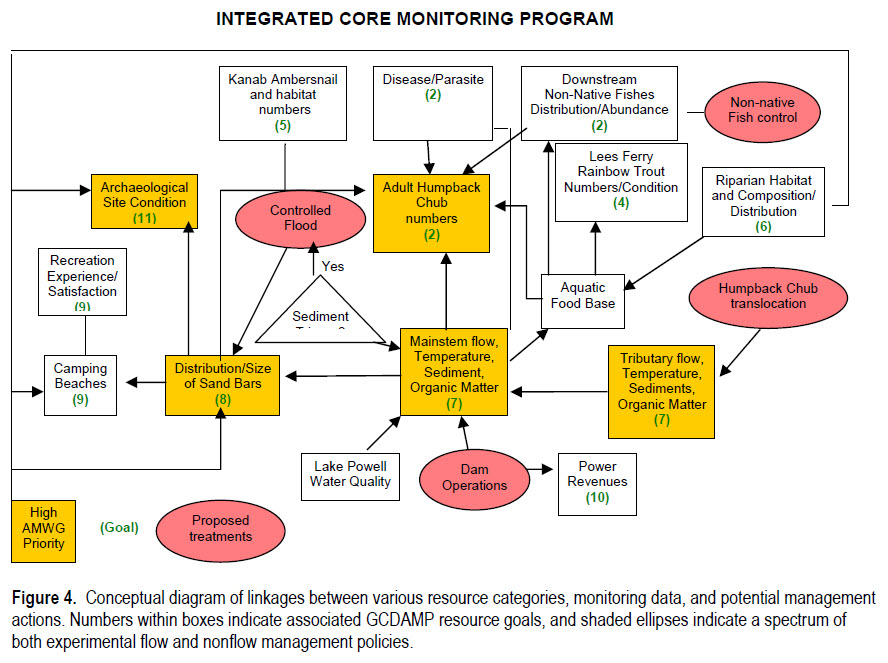Difference between revisions of "Core Monitoring Plan"
Cellsworth (Talk | contribs) |
Cellsworth (Talk | contribs) |
||
| Line 341: | Line 341: | ||
*[https://www.usbr.gov/uc/rm/amp/twg/mtgs/10nov15/Attach_05d.pdf Review of TWG developed Appendix and Related Changes to the GCMRC Draft Core Monitoring Plan] | *[https://www.usbr.gov/uc/rm/amp/twg/mtgs/10nov15/Attach_05d.pdf Review of TWG developed Appendix and Related Changes to the GCMRC Draft Core Monitoring Plan] | ||
*[https://www.usbr.gov/uc/rm/amp/twg/mtgs/10jun29/Attach_06a.pdf E-mail message to the TWG dated June 24, 2010, transmitting the General Core Monitoring Plan for the Glen Canyon Dam Adaptive Management Work Group; Attachment 6b: Core Monitoring Plan: Next Steps PPT] | *[https://www.usbr.gov/uc/rm/amp/twg/mtgs/10jun29/Attach_06a.pdf E-mail message to the TWG dated June 24, 2010, transmitting the General Core Monitoring Plan for the Glen Canyon Dam Adaptive Management Work Group; Attachment 6b: Core Monitoring Plan: Next Steps PPT] | ||
| + | *[https://www.usbr.gov/uc/rm/amp/twg/mtgs/10mar15/Attach_02a.pdf Revised General Core Monitoring Plan (by Shane Capron)] | ||
| + | *[https://www.usbr.gov/uc/rm/amp/twg/mtgs/10mar15/Attach_02b.pdf General Core Monitoring Plan for the GCD-AMP PPT] | ||
| + | *[https://www.usbr.gov/uc/rm/amp/twg/mtgs/10mar15/Attach_02c.pdf Core Monitoring Plan TWG Workshop Results] | ||
| + | *[https://www.usbr.gov/uc/rm/amp/twg/mtgs/10mar15/Attach_02d.pdf Core Monitoring Plan: Next Steps PPT] | ||
|- | |- | ||
Revision as of 16:26, 15 May 2018
|
|
The Core Monitoring Plan describes a general plan and framework for the development of a core monitoring program for the GCDAMP during federal fiscal years 2011 through 2015. Detailed core monitoring plans with explicit methodologies for each resource category will be developed as outlined in this plan over the next several years. The proposed process is consistent with the strategies and objectives described in the Grand Canyon Monitoring and Research Center’s (GCMRC) Strategic Science Plan (U.S. Geological Survey, 2007a) and Monitoring and Research Plan (U.S. Geological Survey, 2007b), and the GCDAMP Strategic Plan as amended by the Adaptive Management Work Group at their August 2003 meeting (AMWG written comm., 2003, hereafter cited as GCDAMP, 2003). Monitoring is a fundamental requirement of the adaptive management process (Walters, 1986; Walters and Holling, 1990). The Department of the Interior (DOI) Adaptive Management Technical Guide (Williams and others, 2007) identifies four primary purposes for monitoring within an adaptive management program:
In 1995, the Grand Canyon Monitoring and Research Center (GCMRC) was created to fulfill the mandate in the 1992 Grand Canyon Protection Act for the establishment and implementation of a long-term monitoring and research program to ensure that Glen Canyon Dam is operated in a manner that protects the values for which the Grand Canyon National Park and the Glen Canyon National Recreation Area were created. Since its inception, many of the GCMRC activities have focused on continuing certain monitoring tasks previously established under the Glen Canyon Environmental Studies program (termed here as “Legacy” monitoring), conducting field experiments, and developing technologies in support of development of a core monitoring program. Implementation of a long-term core monitoring program will require a significant commitment of qualified personnel to ensure that the program is implemented in a sustainable and timely manner. With a few exceptions, much of the data collection is proposed to be performed by cooperating agencies and contractors as discussed below; however, some monitoring, such as quality of water and sediment monitoring that has historically been part of the USGS mission, is proposed to continue internal to the GCMRC and the Water Resources Discipline within USGS. |
| GCDAMP Strategic Plan The GCDAMP Strategic Plan (AMPSP) is a long-term plan drafted in August 2001 by GCDAMP and GCMRC participants that identifies the AMWG’s vision, mission, principles, goals, management objectives, information needs, and management actions. |
Strategic Science Plan The GCMRC Strategic Science Plan (SSP) identifies general strategies for the next five years to provide science information responsive to the goals, management objectives, and priority questions as described in the AMPSP and other planning direction approved by the AMWG. |
Core Monitoring Plan The GCMRC Core Monitoring Plan (CMP) describes the consistent, long-term, repeated measurements using scientifically accepted protocols to measure status and trends of key resources to answer specific questions. Core monitoring is implemented on a fixed schedule regardless of budget or other circumstances (for example, water year, experimental flows, temperature control, stocking strategy, nonnative control, etc.) affecting target resources. |
Monitoring and Research Plan The GCMRC Monitoring and Research Plan (MRP) specifies (1) core monitoring activities, (2) research and development activities, and (3) long-term experimental activities consistent with the strategies and priorities established in this SSP to be conducted over the next five years to address some of the strategic science questions associated with AMWG priority questions. |
Budget and Workplan The GCMRC Triennial Work Plan (TWP) identifies the scope, objectives, and budget for monitoring and research activities planned for a 3-year period. When completed, the triennial work plan will be consistent with the MRP. |
|---|
|
